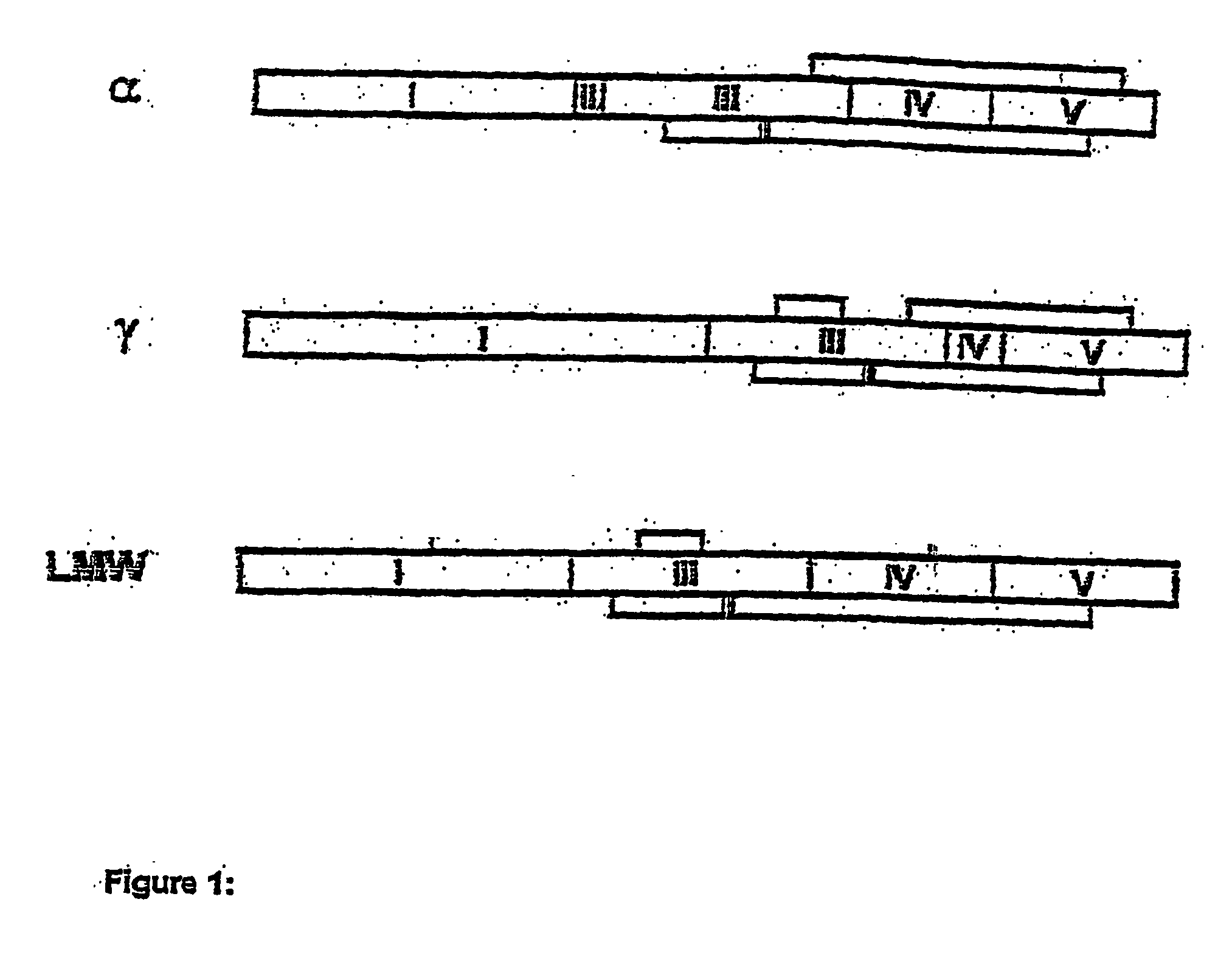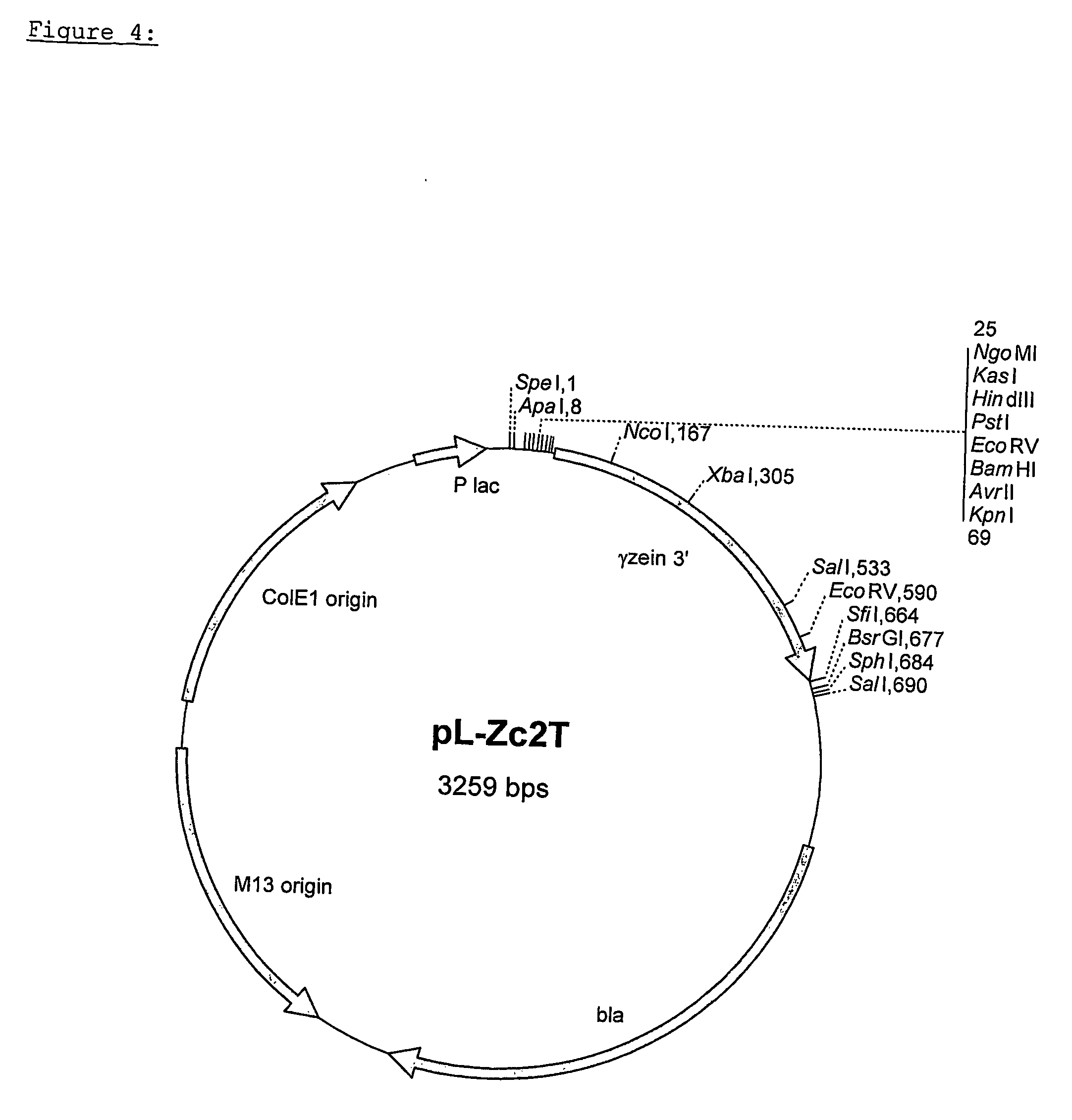Modified low molecular weight glutenin gene in plants
a low molecular weight, plant technology, applied in the field of plants, can solve the problems of increasing the risk of consumption of glutenin-containing products, increasing the risk of nutrient absorption, and increasing the risk of coeliac disease in individuals with severe forms
- Summary
- Abstract
- Description
- Claims
- Application Information
AI Technical Summary
Problems solved by technology
Method used
Image
Examples
example 1
The GUS-reporter Gene Constructs
[0056] The uidA-reportergene construct p1.7γZGUS (Torrent et al. 1997) harbouring the maize 27 kDa γzein gene promoter was obtained from Dr. D. Ludevid (Institut Biologia Molecular Barcelona, Spain).
[0057] The construct pHMW4-GUS harbouring a High Molecular Weight glutenin gene promoter from Triticum aestivum cv. Florida in front of the uidA gene was obtained from Drs. S. Lütticke and S. Sprunck (Institut für Aligemeine Botanik, Universität Hamburg, Germany). It was cloned the following way: The High Molecular Weight glutenin promoter was amplified from genomic DNA of the wheat cv. Florida using the primers HMW1 (5′-CGAATTCGATCCTATATTAATTTTAGACAT-3′) and HMW3 (5′-GCTGCAGATATCTCGGTGGACTATCAGTGAATT-3′). The ends of the PCR fragment were blunted using Pfu DNA polymerase and ligated into the plasmid pCR-Script-Amp (Stratagene, La Jolla, USA) which was linearised with Srf I. From this construct the promoter was amplified with the primers M13 forward and...
example 2
Production of Wheat Plants which Express a Modified LMW Gene from Triticum aestivum.
[0065] The biolistic transformation method is used for the production of wheat (Becker et al., Plant J. 5(2), 1994, 229-307). The vector pHMW-a3Δ2Cz and, for biolistic cotransformation, the vector pAct1-Fneo (Müller et al., Plant Science 114, (1996), 71-82) are used in identical molar ratios in the DNA particle precipitation batch. Scutelli from 14-day old, unripe zygotic embryos of wheat plants were used as target cells for transformation. Transformation was followed by in vitro culture on MS− medium (PCT / EP97 / 02793) containing 2 mg / l 2,4-D (=2,4-dichlorophenoxyacetic acid). Two weeks after transformation, subculture is effected on the same medium, to which 150 mg / l kanamycin sulphate is added. After a further two weeks, the developing calli are transplanted on to a regeneration medium (MS− medium with 0.1 mg / l 2,4-D and 150 mg / l Kanamycin). The developing shoots are transferred to semi-concentrat...
example 3
Production of Maize Plants which Express a Modified LMW Gene from Triticum aestivum
[0066] The biolistic transformation method is used for the production of maize (Brettschneider et al., 1997, Theor. Appl. Genet 94, 737-748). The vector pHMW-a3Δ2Cz and, for biolistic cotransformation, the vector pUbi2loxPAT ( FIG. 12) are used in identical molar ratios in the DNA particle precipitation batch. Vector pUbi.2lox.pat was produced as follows: The loxP sequences are introduced into the cloning vector pUbi.cas (FIG. 13) by PCR. The vector pUbi.cas contains the pUC19 vector (Yannish-Perron et al., 1985, Gene 33: 103-119), the 1.5 Kb ubiquitin promoter and the first exon of the ubi gene and a shortened ubiquitin1 intron (ClaI deletion) (Christensen et al., Plant Mol. Biol. 18, (1992), 675-689) and the 250 bp nos-terminator from Agrobacterium tumefaciens nopalin synthase gene. The loxP sequences are localised 3′ from the Ubiquitin promoter and 3′ from the nos-terminator sequences. Following ...
PUM
 Login to View More
Login to View More Abstract
Description
Claims
Application Information
 Login to View More
Login to View More - R&D
- Intellectual Property
- Life Sciences
- Materials
- Tech Scout
- Unparalleled Data Quality
- Higher Quality Content
- 60% Fewer Hallucinations
Browse by: Latest US Patents, China's latest patents, Technical Efficacy Thesaurus, Application Domain, Technology Topic, Popular Technical Reports.
© 2025 PatSnap. All rights reserved.Legal|Privacy policy|Modern Slavery Act Transparency Statement|Sitemap|About US| Contact US: help@patsnap.com



